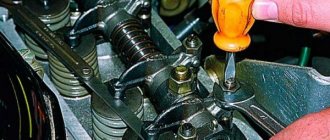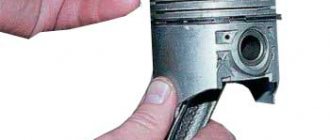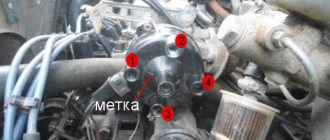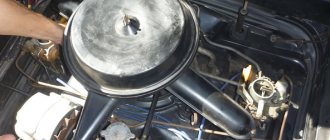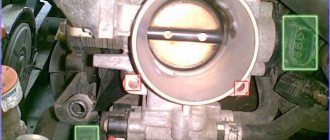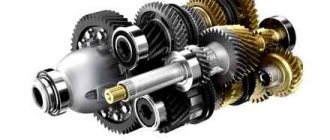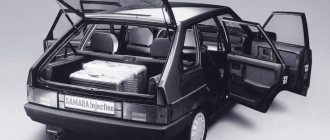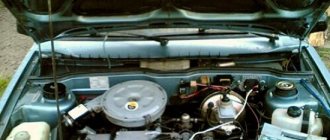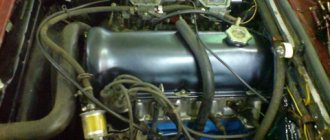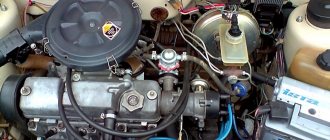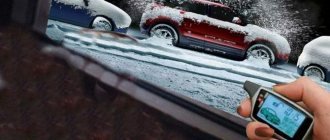Carburetor ZIL-130 K-88A
The ZIL-130 carburetor is vertical, with a downward (falling) mixture flow, with a balanced float chamber.
The carburetor is two-chamber, each chamber has two diffusers. The required mixture composition is obtained due to pneumatic braking of the fuel and the use of an economizer valve. The carburetor has a separate idle system for each chamber, powered from the main fuel channel. To enrich the mixture when the throttle valves are opened sharply, the carburetor has an accelerator pump.
To facilitate starting a cold engine, the carburetor has an air damper with an automatic valve and a kinematic connection between the air and throttle valves. The float chamber, accelerator pump, economizer and air damper are common to both chambers.
The carburetor diagram is shown in the figure.
Rice. Diagram of the ZIL-130 carburetor: 1 - air neck housing; 2 - fuel supply needle valve with an elastic shut-off element made of a special rubber film; 3 - mesh filter; 4 — filter plug; 5 — channel for balancing the float chamber; 6 — idle jet; 7 - cavity; 8 — full power jet; 9 — air jet; 10 — small diffuser; 11 - annular slot; 12 — nozzle; 13 - air cavity; 14 - hollow screw; 15 — air damper; 16 - automatic valve; 17 — pusher; 18 and 34 — springs; 19 and 21 — rods; 20 — bar; 22 - annular groove; 23 — float chamber body; 24 cuff; 25 — cuff spring; 26 — rod bushing; 27 - hole; 28 — intermediate pusher; 29 ball inlet valve; 30 - saddle; 31 - ball valve; 32 — thrust; 33 — economizer valve with mechanical drive; 35 - fuel channel; 36 - plug; 37 — lever; 38 — gasket; 39 - channel; 40 — needle discharge valve; 41 — idle speed adjustment screws; 42 - rectangular hole; 43 — round hole of the idle system; 44 - channel; 45 throttle; 46 — mixing chamber housing; 47 main jet; 48 — float; 49 - float spring
Basic carburetor data
Diffuser diameter in mm:
Diameter of mixing chambers in mm: 36.0
- air neck in mm: 60.0
Throughput of the dosing elements when tested with water under a pressure of 1000 mm at a temperature of 20 ± 1° in cm3/min:
- main jet: 315
- full power jet: 1150
- economizer valve: 215
- air jet: 860
Distance from the fuel level in the float chamber to the upper plane of the float chamber housing connector in mm: 18—19
Float weight in g: 19.7±0.5
Distance between the edge of the throttle valve and the wall of the mixing chamber, corresponding to the moment of opening of the economizer valve with a mechanical drive, in mm: 9.0
The idle speed is controlled by a thrust screw 2, which limits the closing of the throttle valves, and two screws 1, which change the composition of the combustible mixture when the engine is fully warmed up and the ignition system is in perfect working order. Particular attention should be paid to the serviceability of the spark plugs and the correct gap between their electrodes. It should be taken into account that the carburetor is a two-chamber carburetor and the mixture composition in each chamber is adjusted independently of the mixture composition of the other chamber with the appropriate screw. In addition, we must remember that when tightening the screws, the mixture becomes leaner, and when unscrewing them, it becomes richer.
Rice. Adjusting the carburetor idle system: 1 - idle system adjustment screws; 2 - thrust screw
When starting the adjustment, you need to tighten the screws all the way, but not too tightly, and then unscrew each three turns. After this, you should start the engine and use the thrust screw to set the throttle valve to the smallest opening at which the engine operates quite stably. Then you need to lean the mixture using one of the screws 41, turning this screw 1/4 turn at each test until the engine begins to operate with obvious interruptions due to excessive leanness of the mixture in the cylinders. Then you should enrich the mixture by turning out screw 41 1/2 turn. After adjusting the mixture composition in one chamber, the same operations must be performed with the second screw.
Having adjusted the mixture, you should try to reduce the idle speed by gradually unscrewing the throttle valve thrust screw, after which you should again try to lean the mixture using the screws, as indicated above. Usually, after two or three attempts, you can find the correct position for all three adjustment screws.
Do not set the engine idle speed to a very low speed. To check the idle speed adjustment, press the throttle pedal and immediately release it sharply. If the engine stops working, the idle speed must be increased. A properly adjusted carburetor should ensure stable operation of a serviceable engine at idle.
VAZ 2109 shoots Repair VAZ 2108 2109 21099
Thursday, June 18th, 2015
Very often on VAZ cars it happens that the engine fires. Naturally, the VAZ 2109 is no exception. The engine can shoot in two places: 1) the VAZ 2109 shoots at the carburetor. 2) the VAZ 2109 shoots at the muffler. The reasons for these two unpleasant shots are similar, although different. Let's first look at why the VAZ 2109 shoots at the carburetor?
VAZ 2109 shoots into the carburetor
1) Ignition too early. That is, a spark occurs in the cylinder even before the intake valves close. As a result, the mixture in the cylinder ignites ahead of schedule and flows into the VAZ 2109 carburetor through the holes of the intake valves. If you observe this process with the air filter cover removed, you can easily see flashes of flame from the chambers of the VAZ 2109 carburetor. To eliminate too early ignition, it is necessary to correctly set.2) The valve timing is disrupted, or in simple terms - the timing belt of the VAZ 2109 has slipped. In this case, the same story turns out - a spark is supplied when the intake valves are open. In order to check the valve timing, you need to check two marks: on the camshaft gear and flywheel of the VAZ 2109. 3) The intake valve of the VAZ 2109 is stuck or burnt out. Naturally, not every cylinder necessarily fires. The valve may stick or burn out on any of them. To check, remove the cover and turn the crankshaft by hand, visually checking the correct operation of all intake valves of the VAZ 2109 engine. 4) The high-voltage wires of the VAZ 2109 are connected incorrectly. For example, if the wires of the second and third cylinders are swapped, then shooting is guaranteed. The timing of the spark supply is different for the cylinders, so again, when the spark is supplied to the wrong cylinder, it may well be supplied at the moment when the valves are open. 5) The vacuum corrector of the ignition distributor of the VAZ 2109 is faulty. As the speed increases, the vacuum in the engine intake manifold increases and this vacuum is supplied through the tube to the vacuum corrector. If it does not work, then there will be no adjustment of the ignition timing. 6) Spark plugs with carbon deposits. If, at the moment of supplying the combustible mixture, there are hot particles left on the spark plug or the cylinder walls of the VAZ 2109, then they ignite it and a shot occurs. Also, these particles are the cause of the glow ignition of the VAZ 2109, when after turning off the ignition the engine continues to jerk. Now let’s look at the reasons why that the VAZ 2109 shoots into the muffler. As you probably guessed, the problem here is that the spark is supplied when the exhaust valves are open.
VAZ 2109 shoots into the muffler
1) Ignition too late. A spark in the cylinder occurs at the moment when the exhaust valves of the VAZ 2109 engine are already open. As a result, the mixture in the cylinder ignites later than the required moment and goes through the exhaust valve openings into the muffler of the VAZ 2109. In the dark, sometimes you can see flashes from the exhaust pipe when it’s really accelerating. To eliminate too late ignition, it is necessary to set it correctly. 2) The valve timing is disturbed, or in simple terms - the timing belt of the VAZ 2109 has slipped. The same story turns out - the spark is supplied when the exhaust valves are open. In order to check the valve timing, you need to check two marks: on the camshaft gear and flywheel of the VAZ 2109. 3) The exhaust valve of the VAZ 2109 is stuck or burnt out. Naturally, not every cylinder necessarily fires. The valve may stick or burn out on any of them. To check, the cover is removed and the crankshaft is turned by hand, the correct operation of all exhaust valves of the VAZ 2109 engine is visually checked. it may well be supplied at the moment when the valves are open. 5) The vacuum corrector of the ignition distributor of the VAZ 2109 is faulty. With increasing speed, the vacuum in the engine intake manifold increases and this vacuum is supplied through a tube to the vacuum corrector. If it does not work, then there will be no adjustment of the ignition timing. 6) Spark plugs with carbon deposits. If, at the moment of supplying the combustible mixture, there are hot particles left on the spark plug or the cylinder walls of the VAZ 2109, then they ignite it and a shot occurs. Also, these particles are the cause of the glow ignition of the VAZ 2109, when after turning off the ignition the engine continues to jerk.
To home.
No spark VAZ 2109
The operating order of the VAZ 2109 cylinders
VAZ 2109 won't start
Carburetor care and adjustment
It is necessary to remove sediment from the carburetor and clean it.
The ZIL-130 carburetor must be washed with clean gasoline or acetone, followed by blowing with compressed air. The carburetor has rubber and rubberized parts (limiter system diaphragm, paronite gaskets, etc.), in addition, a fuel supply valve and an economizer valve with an elastic locking element (made of special rubber) can be installed, so flushing with acetone or solvents based on it is necessary carry out only after unscrewing these components from the carburetor body parts. Valve knocking and compression of the seat by the valve are not allowed.
When disassembling the carburetor, removing the upper housing, it is necessary to unscrew the hollow screw 14. It must be taken into account that the discharge needle valve 40 is not secured and may fall out of the housing.
It is strictly forbidden to use wire or any metal objects to clean jets, injectors, channels and holes. It is forbidden to blow compressed air through the fuel inlet and balancing tube of the assembled carburetor, as this will damage the float.
When storing carburetors for a long time, measures must be taken to protect them from corrosion, contamination and damage.
High voltage wires
When carrying out repairs affecting the ignition system, the high-voltage wires may be connected incorrectly. In this case, the spark will not occur in time with the compression cycle, resulting in popping sounds. Even if the engine starts, its power is not enough to move the car.
To diagnose a malfunction, you should check the connection of the wires from the spark plugs to the distributor. You should push off from the mark located on the cover. The connection of high-voltage wires must correspond to the car model. For example, the location of high-voltage wires in the VAZ 2109 is shown below.
Can a popping sound in the muffler damage the engine?
Sharp sounds from the exhaust system are a consequence of inaccurate adjustment of the internal combustion engine or a failure of its settings. The following systems need to be checked:
- gas distribution mechanism;
- fuel supply system;
- ignition system;
- ICE sensors (in injection engines).
Popping noises do not pose any particular danger to the engine, but if you delay troubleshooting, problems cannot be avoided. A delay in restoring faulty components can lead to destruction of the valves and problems in the exhaust system. Sometimes such a breakdown even leads to a car fire.
But there are also positive aspects to the “sneezing” of the muffler - this is how the car makes it clear that there is a malfunction that needs to be fixed. Before repairs, it is necessary to carry out comprehensive diagnostics of the motor. Sometimes you need to adjust or replace some consumables.
Switch failure
Typically, a breakdown of the switch makes it impossible to start the engine, so popping noises will be observed when trying to start. To diagnose, just install a new device. If the motor stops firing, then the switch needs to be replaced or repaired. What to do depends on the type of breakdown and the capabilities of the car owner.
Very often this malfunction can be detected at an early stage. The engine speed begins to fluctuate, and when you sharply press the gas pedal, the car accelerates with dips in traction. Small popping noises are heard from the engine compartment.
Why does the silencer shoot: reasons
The main reason for the appearance of pops is incomplete combustion of fuel. Once it enters the exhaust system, it ignites. The process is accompanied by a noise similar to cotton. The force of the explosion depends on the amount of unburned fuel. Sometimes you can even hear a whole line of shots. By the way, sometimes it shoots into the muffler when the gas is suddenly released or when you press it - and a lot of smoke comes out of the exhaust pipe. A breakdown is indicated by a loss of internal combustion engine power and an increase in fuel consumption.
There are other reasons why popping occurs.
Air filter
The fuel mixture is formed from fuel and air - the components must be mixed in certain proportions. The filter does not allow air to pass through if it is clogged. As a result, the lack of oxygen will lead to incomplete combustion of the fuel. Through the manifold, the fuel enters the exhaust system, where an explosion occurs as a result of heating.
Carburetor
An explosion in the exhaust system can also occur due to incorrect carburetor settings. The purpose of the unit is to form the correct air-fuel mixture. There should not be a lot of fuel in the mixture, otherwise everything described in the previous paragraph will happen. Popping noises will only be heard when the gas is released.
Jets
Jets are filter elements that allow air mass to pass through them. They are used in carburetor engines. There are 2 common causes of malfunction: clogging due to prolonged use and incorrect settings. This leads to a lack of oxygen and incomplete combustion of the fuel - as is the case with air filters. Due to the lack of oxygen, the mixture becomes oversaturated with gasoline - hence the popping noise.
Ignition system
This node also needs to be configured properly. Usually “shots” are a consequence of late ignition. The point is this: a spark is formed when the supply valve is fully opened. This causes fuel to enter the manifold, and then into the exhaust. With early ignition, “shots” can also occur, but only in the air filter. Explosions in the muffler due to late ignition lead to burnout of the intake valve.
Candles
Incomplete combustion of fuel may occur due to insufficient spark. Possible reasons:
- Poor contact at wire terminals.
- Distributor malfunction.
- Spark plug failure. Even one burnt element can seriously affect sparking. As a result, a weak spark will be produced, and the fuel will not burn out completely.
Thermal gap
Thermal gap is the permissible gap between the parts of the motor when heating. It can be observed between the camshaft lobes and valve lifters. The gap must be adjusted according to specifications.
Indirect signs of an increase in the gap are a decrease in engine power and increased noise during operation. Insufficient clearance causes “shots” in the exhaust. The logic of what is happening is as follows: if the valve is not completely closed, part of the fuel will pass through it into the manifold, and from there into the exhaust.
Lean fuel assembly
Operating a carburetor on a lean fuel assembly often becomes a source of popping noise a priori. This is due to the combustion process itself, which in this case occurs slowly. Symptoms of this type of malfunction are similar to ignition failures. The poor fuel assembly burns after a new intake stroke begins.
Lean fuel mixture
A lean fuel assembly is almost the main reason for overheating of the power plant. The pop is created first in the intake, and only then the sound is transmitted to the mixing chamber of the carb.
The root causes of the formation of a lean fuel assembly must be sought in the carburetor itself, fuel lines, filters or in the fuel pump. As a rule, this is due to air penetration into the system or clogging of the jets, which are the main components - dispensers.
It is also important to be able to check at what level the fuel is in the float chamber. Often something similar happens due to the curvature of the float.
At the same time, it would be a good idea to test the accelerator pump. This part of the carburetor can also play a role when shots appear. This is especially true if it shoots when you press the gas pedal.
Carburetor accelerator pump
If the problem is related to the carburetor and its components, then sometimes it is enough to treat the inside of the device with an aerosol spray to clean the metering devices. After that, all that remains is to properly adjust everything. It would also be a good idea to replace the fuel filters.
Shots in the carburetor often appear after repairs at a service station. A crookedly installed mechanism belt is the reason for this. Needless to say, this negatively affects the entire gas distribution process. A phase failure occurs and the fuel assembly burns out untimely.
Timing belt
The problem is “treated” by correctly aligning the belt to the marks. If the rubber has lost its original properties, then it is advisable to replace such a part with a new one.
The reasons for shooting into the carburetor and troubleshooting are clearly visible in the table.
How to diagnose and what exactly needs to be checked?
First, you need to check the air filter located at the entrance to the exhaust system. If it is very dirty, it will have to be replaced, since the air filter cannot be cleaned. Problems can be avoided if you change the element on time.
If the carburetor is faulty, you need to check the gasoline chamber in which the float is located. The settings for all carburetors are individual, so the level is required in each case. The float should be level with the lid. Otherwise, the carburetor needs to be adjusted.
The float itself may show an incorrect value due to damage. For example, if this element has a hole, fuel penetrates inside it. Naturally, after this the readings will be incorrect.
When diagnosing, you need to check the spark plugs and replace failed elements. New spark plugs must have the same heat rating as the removed ones.
The thermal clearance of the cylinder head needs to be adjusted - if it is incorrect. The valves on all cylinders are manually adjusted when cold.
Problems with the timing belt can be resolved by tightening it or replacing it (if tightening does not produce results). But if there is significant wear, we definitely replace the toothed pulley. Worn valves can be sanded if they have scratches, or ground in if there are rough spots.
Shots in the muffler area occur regardless of the type of engine - be it an injector or a carburetor. They happen at idle and when the engine is warm. But this is only an external sign - behind it lies serious problems that need to be solved immediately.
Doesn't develop speed
If the engine is in good working order, but the walk-behind tractor does not develop speed, then it is possible:
the air filter is clogged. As a result, not all the air enters the carburetor, and the fuel becomes oversaturated; low quality fuel fluid; parts of the ignition system have failed
As mentioned earlier, it is necessary to check the spark plug, correct the gap between the electrodes, and pay attention to the mechanical integrity of the electrical circuit; if necessary, clean the carburetor and adjust it correctly; the operation of pistons and cylinders is interconnected with engine power.
Therefore, pay attention to the condition of the pistons and cylinders. Their external damage can significantly reduce the compression value
For example, cleaning the carburetor may solve the problem
Setting up a Zilov carburetor yourself
ZIL 130 and 131, cars that can be called legendary without exaggeration. They were produced for almost 50 years and were used in almost all areas of industry and defense. The secret of the success of 130 and 131 is very simple - the cars were as reliable as possible and did not let their owners down. This was achieved thanks to the almost perfect spare parts produced by Soviet factories. One of these parts is the carburetor for 88a, which was installed on these cars. The device rarely failed and required virtually no repairs. However, all this is only provided that the driver monitored the condition of the carburetor and periodically adjusted it.
Today, ZILs 130 and 131 still remain reliable workhorses. However, given the fact that in the 21st century, the production of these cars was significantly reduced, today most of them, one might say, are retirees of the Soviet automobile industry. Old cars very often require repairs, and the 88a carburetor becomes not so reliable over time, and if it is not adjusted in a timely manner, the part may fail and will have to be replaced.
Design features of the carburetor
Before you begin setting up or adjusting a spare part, you should study the operating principle of the carburetors installed on ZIL 130 and 131. So, this is a two-chamber device with a falling flow of air mixture and double sawing of fuel. There are two carburetor chambers made in one block and operate in all engine modes in parallel.
The carburetor in ZIL 130 and 131, by the way, is designed in such a way that its adjustment is not a problem for the driver. If the device gets a little rough, you can set it up to work without having to remove and disassemble the device. However, before you begin tuning the carburetor, it is necessary to study its design even superficially. In particular, the screws with which the actual adjustment is made:
- Idle mixture quality adjustment screw.
- Throttle stop screw.
- Speed adjustment screw.
- Throttle locking screw.
- Jet holder.
Carburetor K 88
The carburetor itself is an order of magnitude more complex. However, this knowledge is sufficient for initial setup. Deeper ones are needed more for repairing the device, however, we will entrust this matter to qualified auto mechanics. If you have minimal plumbing skills, adjusting the idle speed as a solution to most problems with ZIL 130 and 131 carburetors will not be a problem for you.
Idle speed adjustment
One of the main diseases of Zilov carburetors is the so-called floating idle. Simply put, due to one or another malfunction in the cylinder block, the fuel mixture is of poor quality. In this case, the car will noticeably stall at idle, and the speed will noticeably fluctuate. The problem is solved quite simply. You just need to adjust the screws responsible for the composition of the fuel mixture. Let's look at the whole process step by step.
- First of all, you need to completely tighten the screw, which is responsible for the quality of the fuel mixture. After the screw reaches the stop, it needs to be loosened by 4-5 turns. Thus, you will achieve a fuel mixture that is ideally enriched for the cylinder block.
- In the same way, tighten the mixture quantity screw until it stops. The only difference is that it will only need to be loosened 3 turns.
- Now you can start the engine. After turning on the ignition, be sure to wait until the car warms up sufficiently.
- Now take a screwdriver and use the mixture screw to adjust the carburetor so that the engine runs stably at 800 rpm.
- Now close the quality screw until the engine starts to sneeze. Afterwards it should be loosened by about half a turn.
Inlet valve
A bent or burnt valve is unable to seal the combustion chamber from the carburetor. Loose pressure of the plate to the seat allows gases to break into the intake manifold. In some cases, the fresh air-fuel mixture ignites.
To diagnose the problem, you need to check the compression. If a cylinder is detected with a suspected combustion chamber leak, it is necessary to fill it with engine oil. This will prevent excessive wear of the cylinder-piston group or sticking of the piston rings. A cylinder with a damaged valve shows the same compression both with and without oil.
To eliminate the malfunction, it is necessary to dismantle the cylinder head and replace the valve. If the valve is bent, it is recommended to check the correct timing of the timing belt. Burnout of the valve with low mileage also requires searching for the cause of this breakdown.
If you have hydraulic boosters, you should also check their operation. Sticking of the hydraulic compensator leads to the same consequences as burnout of the valve. In this case, shooting into the carburetor may not be observed all the time, but during certain periods, for example, when the engine is cold or hot. Very often, car owners complain that they shoot when I start the engine.
Types of carburetor malfunctions
True, such adjustment does not always help to solve all problems with the carburetor. Sometimes the device requires repair or more complex maintenance. In total, there are 4 problems with Zilov carburetors. In principle, all of them can be easily fixed and a professional driver will be able to fix everything without going to a car service center.
First of all, we are talking about problems such as:
- Condensation in the carburetor. The problem is very common, especially recently, when the quality of fuel leaves much to be desired. Most likely, something very vaguely reminiscent of gasoline got into the gas tank, probably diluted with water or donkey urine, as it was in the famous film. Naturally, the appearance of condensation in the carburetor of ZIL 130 and 131 is also due to the fact that these cars are operated year-round and often even in severe frosts. Low-quality gasoline freezes when the car is idle and, as a result, condensation forms in the carburetor. The only solution to the problem is to replace the fuel with a higher quality one.
- Popping or shooting sounds in the carburetor. A malfunction that may have several causes. The most likely two of them are, first of all, low-quality fuel. In this case, an insufficiently enriched air mixture enters the carburetor. It ignites in parts and the driver hears pops or shots in the carburetor. The second option is a problem with the jets, which could become clogged. They can be cleaned with a stream of air or washed with a special liquid. If all actions are performed correctly, the shots and claps will stop.
- Gasoline is not supplied. The most likely cause is mechanical blockage in the carburetor. To fix the problem, it will have to be disassembled and thoroughly cleaned. At the same time, it is worth checking all the hoses leading to the device for defects - there may be problems in them too.
- Overfills the carburetor. A very common problem. The problem is that too much fuel is entering the carburetor. First of all, try adjusting the air mixture quality screw. If it doesn’t help, you should buy new spark plugs; it is possible that the problem lies with them.
These are, perhaps, all the faults that can be fixed without any problems with your own hands. Everything else will most likely require the intervention of qualified auto mechanics, who are capable of fine adjustment of the carburetor installed on ZIL 130 and 131. By the way, you shouldn’t take on this matter on your own - the process is very lengthy and labor-intensive, and in the absence of practical knowledge, you can completely ruin the fuel system system ZIL 131 and 130, in this case no adjustment will help.
Carburetor care
All of the above problems with carburetors ZIL 130 and 131 will never affect you if you follow a number of simple rules and care for the carburetor as required by its design:
- The most important rule is that during each vehicle maintenance, check that all connection plugs and carburetor plugs are tight. Leakage of the fuel mixture from the device can have a very detrimental effect on its further operation.
- Also, at each maintenance, be sure to remove sediment from the float chamber and clean and rinse the carburetor channels and jets at least a couple of times a year. (It is best to wash the device with high-octane gasoline, and if the contamination is too strong, you can use acetone for this purpose).
- Be sure to dry the washed parts and then clean them again with a soft cloth.
Of course, a clogged carburetor will not necessarily cause it to malfunction. However, if you do not maintain the device, problems with your ZIL will not keep you waiting.
Plant structure
The first and practically main element of a chainsaw is the engine, namely a two-stroke carburetor (see carburetor adjustment). Its direct power can be varied, it all depends on the model of the device and its intended purpose.
Chainsaw set The second no less important part of the tool is the set (saw) which consists of a chain (cutting), bar, sprocket, wheel (chain). It is worth adding to this that completely different manufacturers provide their own specific range of this headset.
It is important that it always needs to be directly selected from the specific characteristics of the engine. Since the larger the pitch of this type of headset, the deeper the chainsaw’s cut will be, one might even say that the more powerful and productive it will be. Often chainsaw owners think about why the chainsaw shoots into the carburetor, or why gasoline does not flow into the chainsaw carburetor? But do not forget that for the device to fully operate, the engine should also not be inferior to it in terms of power.
Its lubrication is carried out using special oil directly from the second tank, which is located on the hand unit. It is worth noting that the mass of this type of tank has such features that the oil and fuel intended for the engine run out at the same time.
We have figured out the general outline of the device, and most likely its basis, and now it’s time to start understanding why the chainsaw stopped working, what the reasons could be for this and how to eliminate them.
